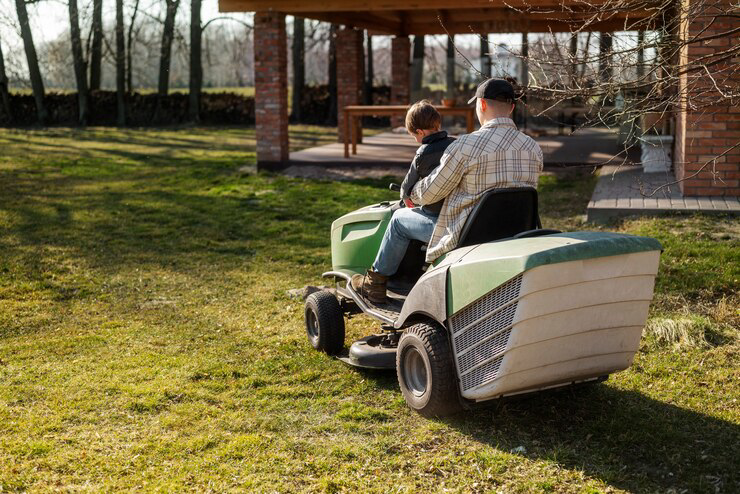The first step in cultivating a greener future is adopting eco-friendly lawn care techniques. The need to incorporate environmentally friendly solutions into every part of our life is growing as our knowledge of environmental sustainability rises. This guide to eco-conscious lawn care practices will cover practical methods for maintaining healthy lawns with the least possible impact on the environment. Together, let’s make the transition to a more sustainable and optimistic future for our world and its people.
Eco-Friendly Lawn Care Is Necessary:
As we address the issues of environmental stewardship, we must recognise the importance of providing environmentally friendly lawn care. Conventional lawn care methods harm ecosystems, rely on chemical fertilisers and pesticides, and consume excessive water. Reduced soil health, poisoned rivers, and disrupted biodiversity are the results. Choosing eco-friendly solutions means more than just maintaining a nice lawn—it means protecting the delicate balance of our planet. Transitioning to sustainable practices helps protect the environment and ensure that future generations have a place to live. It’s an all-encompassing approach founded on the understanding that our actions now will determine the kind of world we leave for future generations. Let’s take care of more than just beautiful lawns; let’s create a legacy that endures for upcoming generations and encourages harmonious coexistence between humans and the environment.

Recognising Eco-Friendly Lawn Maintenance
Cultivating a greener future through sustainable lawn care involves a genuine commitment to harmonizing our outdoor spaces with the natural world. It prioritizes practices that protect ecosystems and minimize ecological harm, such as replacing synthetic chemicals with organic alternatives to foster biodiversity and soil health. Efficient irrigation methods like rainwater collection and drip irrigation reduce water waste and promote sustainable water usage. Natural pest control methods like companion planting and introducing beneficial insects ensure pest control without compromising environmental integrity. By aligning with the laws of nature, we cultivate resilient, vibrant lawns that thrive in harmony with the Earth’s health. Ultimately, sustainable lawn care is about sowing the seeds for a better, more sustainable future where people and the environment coexist harmoniously, transcending the goal of simply having greener lawns.
Choosing Organic Fertilisers:
The foundation of environmentally responsible lawn care is organic fertilisers, which provide a sustainable and safe substitute for their synthetic equivalents. In contrast to chemical fertilisers, organic alternatives provide lawns with natural, nutrient-rich fertilisers that improve microbial activity and soil health. These goods, which include compost, manure, and specialised organic blends, put environmental and human safety first. Using organic fertilisers helps us create safer, more sustainable ecosystems for all living things and greener lawns. Organic fertilisers facilitate the peaceful coexistence of humans and the natural world, from kids playing in the backyard to wildlife walking unhindered. It’s about creating a healthy environment where life thrives harmoniously with the Earth’s natural rhythms, not just about maintaining gorgeous lawns.
Putting Water-Saving Strategies into Practice:
Water conservation is especially important for sustainable lawn maintenance in areas prone to drought. In addition to preserving the health of our lawns, efficient water management reduces environmental stress. Modern innovations that maximise efficiency include rainwater gathering systems and drip irrigation, which precisely supply water to the root zones. In addition, using native plants and drought-tolerant landscaping lowers water usage and improves the resilience of lawns. By adopting these tactics, we encourage colourful lawns and create a water-conserving environment that can flourish in trying circumstances. Our dedication to sustainability ensures that our outdoor spaces stay vibrant and healthy for future generations, paving the path for a greener, more resilient future.

Accepting Natural Approaches to Pest Control:
Usually, poisonous chemicals are used in conventional pest control, which puts animals and beneficial insects in danger. Still, there are safer options found in natural ways. Two safe, non-toxic pest management strategies are introducing beneficial insects like ladybirds and fostering biodiversity. Additionally, companion planting—combining grassy lawn plants with plants that repel pests—effectively discourages pests while promoting a healthy ecosystem. By adopting these natural methods, we safeguard our lawns and maintain the complex interdependencies of life. By promoting harmony between humans and nature, this dedication to natural pest management helps create a more sustainable and healthy environment. It’s not only about protecting our lawns; it’s also about creating a whole ecosystem where all living things coexist peacefully with the environment.
In conclusion, using environmentally friendly lawn care methods is not just a choice; we owe it to future generations and our planet. By emphasizing organic fertilizers, efficient water management, natural pest control methods, and other sustainable techniques, we grow bright, resilient lawns and contribute to a greener, more sustainable future. Every step taken to make the planet greener has a ripple effect that extends beyond biodiversity preservation and slows down climate change. As stewards of the earth, we should take care of our lawns in an environmentally conscious manner because the world we leave for future generations is affected by the daily decisions we make. Let us exercise caution when leaving our mark, recognize our impact, and remain committed to encouraging harmonious coexistence between humans and the environment. Let’s cultivate a greener future one grass blade at a time.

